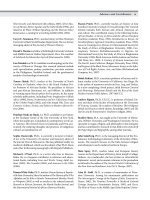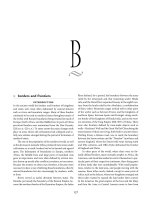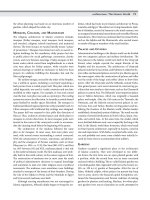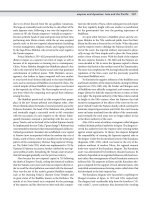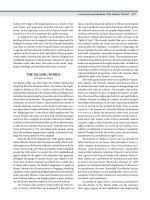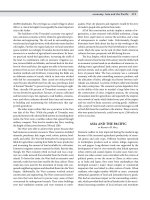Encyclopedia of society and culture in the medieval world (4 volume set) ( facts on file library of world history ) ( PDFDrive ) 154
Bạn đang xem bản rút gọn của tài liệu. Xem và tải ngay bản đầy đủ của tài liệu tại đây (60.81 KB, 1 trang )
B
•
▶ borders and frontiers
introduction
In the ancient world the borders and frontiers of kingdoms
and states were most often delineated by natural features
such as rivers and mountain ranges. Many of these borders
continued to be used in medieval times throughout much of
the world, with Roman boundaries being retained in much of
Europe, North Africa, and the Middle East. In parts of China
provincial borders were maintained from the Han Dynasty
(202 b.c.e.–220 c.e.). To some extent the main changes took
place in areas where old civilizations had collapsed and totally new entities emerged during the period of formation of
medieval states.
The rise in the population of the medieval world, as well
as the decrease in nomadic tribes, produced more areas under
cultivation; as a result, borders had to be formed and agreed
upon. The delineation of boundaries in Europe, northern
Africa, the Middle East, and large parts of mainland Asia
grew in importance and were often defined by written treaties, drawn up mostly after conflicts, invasions, or incursions.
Because the treaties set down exact borders, it became more
necessary to have a way of defining these boundaries, often by
natural boundaries but also increasingly by markers, walls,
or forts.
Rivers served as useful divisions between states. The
Danube, previously the boundary of the Roman Empire, became the northern border of the Byzantine Empire; the Indus
River defined, for a period, the boundary between the areas
ruled by the Umayyads and that remaining under Hindu
rule; and the Havel River separated Saxony in the eighth century from the lands ruled by the Abodrites, a confederation
of Slavic tribes. Mountain ranges worked well in other parts
of the world, such as between France and the kingdoms of
northern Spain, between Spain and Portugal, along northern border of the kingdoms of Hindu India, and on the western extremes of the Tang Empire (608–907) of China. There
were also frontiers defined by man-made objects such as
walls—Hadrian’s Wall and the Great Wall of China being the
most famous of those surviving, both built in ancient times.
Watling Street, a Roman road, was to mark the boundary
between the Saxon realms and the “Danelaw” (northern and
eastern England, where the Danes held sway) during ninth
and 10th centuries, and Offa’s Dyke delineated the frontier
of England and Wales.
In other parts of the world, where there were no formally defined borders, many nomadic peoples in Africa, the
Americas, and Australia tended to restrict themselves to particular parts of their respective continents, there being parts
of those lands that were uninhabitable. With small populations, relative to the land area, and people moving with the
seasons, these tribes rarely clashed, except in some parts of
Africa such as the Sahara, where new kingdoms emerged and
their rulers wanted to expand the land under their control.
In the Americas the great empires of the Inca and the Maya
and then the Aztec in Central America seem to have been
127

